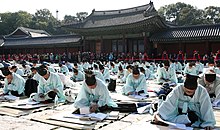
The imperial examination was a civil service examination system in Imperial China administered for the purpose of selecting candidates for the state bureaucracy. The concept of choosing bureaucrats by merit rather than by birth started early in Chinese history, but using written examinations as a tool of selection started in earnest during the Sui dynasty (581–618) then into the Tang dynasty of 618–907. The system became dominant during the Song dynasty (960–1279) and lasted for almost a millennium until its abolition during the late Qing dynasty reforms in 1905. Aspects of the imperial examination still exist for entry into the civil service of contemporary China, in both the People's Republic of China and Taiwan.

Joseon, officially Great Joseon State, was a dynastic kingdom of Korea that lasted just over 500 years. It was founded by Taejo of Joseon in July 1392 and replaced by the Korean Empire in October 1897. The kingdom was founded following the aftermath of the overthrow of Goryeo in what is today the city of Kaesong. Early on, Korea was retitled and the capital was relocated to modern-day Seoul. The kingdom's northernmost borders were expanded to the natural boundaries at the rivers of Amnok and Tuman through the subjugation of the Jurchens.

Korean Confucianism is the form of Confucianism that emerged and developed in Korea. One of the most substantial influences in Korean intellectual history was the introduction of Confucian thought as part of the cultural influence from China.

Neo-Confucianism is a moral, ethical, and metaphysical Chinese philosophy influenced by Confucianism, which originated with Han Yu (768–824) and Li Ao (772–841) in the Tang dynasty, and became prominent during the Song and Ming dynasties under the formulations of Zhu Xi (1130–1200). After the Mongol conquest of China in the thirteenth century, Chinese scholars and officials restored and preserved neo-Confucianism as a way to safeguard the cultural heritage of China.
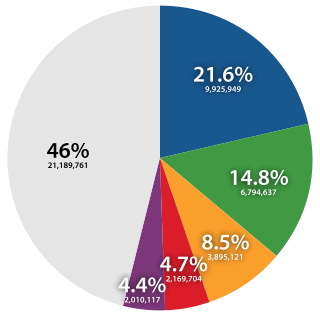
Lee, I, or Yi (이) is the second-most-common surname in Korea, behind Kim (김). As of the South Korean census of 2015, there were 7,306,828 people by this name in South Korea or 14.7% of the population.
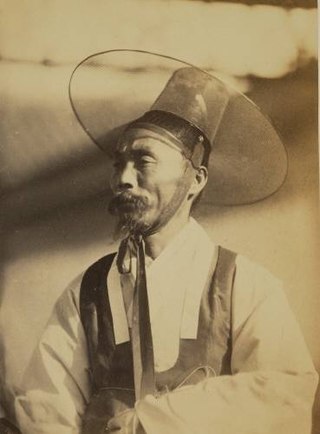
The yangban were part of the traditional ruling class or gentry of dynastic Korea during the Joseon Dynasty. The yangban were mainly composed of highly educated civil servants and military officers—landed or unlanded aristocrats who individually exemplified the Korean Confucian form of a "scholarly official". They were largely government administrators and bureaucrats who oversaw medieval and early modern Korea's traditional agrarian bureaucracy until the end of the dynasty in 1897. In a broader sense, an office holder's family and descendants, as well as country families who claimed such descent, were socially accepted as yangban.

Jeong Do-jeon, also known by his art name Sambong (삼봉), was a prominent Korean scholar-official during the late Goryeo to the early Joseon periods. He served as the first Chief State Councillor of Joseon, from 1392 until 1398 when he was killed by the Joseon king Yi Bang-won. Jeong Dojeon was an adviser to the Joseon founder Yi Seong-gye and also the principal architect of the Joseon dynasty's policies, laying down the kingdom's ideological, institutional, and legal frameworks which would govern it for five centuries.
Historically, Korea was differently ruled and named. The official records on organised education start with Three Kingdoms period.

A mandarin was a bureaucrat scholar in the history of China, Korea and Vietnam.
The politics of the Joseon dynasty, which ruled Korea from 1392 to 1897, were governed by the reigning ideology of Korean Confucianism, a form of Neo-Confucianism. Political struggles were common between different factions of the scholar-officials. Purges frequently resulted in leading political figures being sent into exile or condemned to death.
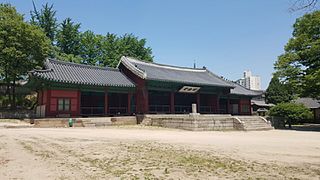
Sungkyunkwan (Korean: 성균관) was the foremost educational institution in Korea during the late Goryeo and Joseon Dynasties. Today, it sits in its original location, at the south end of the Humanities and Social Sciences Campus of Sungkyunkwan University in Seoul, South Korea. Twice a year, in May and September, the ceremonial rite Seokjeon Daeje is performed in the Munmyo Shrine, to honor Confucius and the Confucian sages of China and Korea.
The Gukjagam, known at times as Gukhak or Seonggyungwan, was the highest educational institution of the Korean Goryeo dynasty. It was located at the capital, Gaegyeong, and provided advanced training in the Chinese classics. It was established in 992 during the reign of Seongjong. Its name has been changed to Songgyungam in 1298 and to Songgyungwan in 1308. Its current name is Koryo (/Goryeo) Songgyungwan University/University of Light Industry. A similar institution, known as the Gukhak, had been established under Unified Silla, but it was not successful.

Hyanggyo were government-run provincial Confucian schools established during the Goryeo (918–1392), and Joseon periods in Korea. They were established to educate and train officials in Confucian ideals and the ethics of government. In the Joseon period, when Neo-Confucianism replaced Buddhism as the ruling ideology, the government needed to promote the new ideology to create a new social order based on Neo-Confucianism. During this period also, teachers at Hyanggyo received land, royalties, and slaves from the government.
The Gukhak was the sole recorded institution of higher learning in the Silla period of medieval Korean history. It provided training in the Chinese classics. An earlier institution, the Taehak, had been founded in 372.
Cheonmin, or "vulgar commoners", were the lowest caste of commoners in dynastical Korea. They abounded during the Goryeo (918–1392) and Joseon (1392–1897) periods of Korea's agrarian bureaucracy.

The gwageo (Korean: 과거) or kwagŏ were the national civil service examinations under the Goryeo (918–1392) and Joseon (1392–1897) periods of Korea. Typically quite demanding, these tests measured candidates' ability of writing composition and knowledge of the Chinese classics. The form of writing varied from literature to proposals on management of the state. Technical subjects were also tested to appoint experts on medicine, interpretation, accounting, law etc. These were the primary route for most people to achieve positions in the bureaucracy.
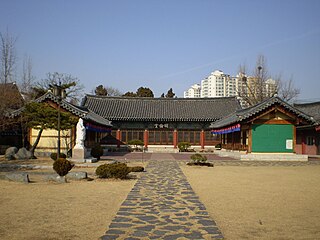
The Daegu Hyanggyo (Korean: 대구향교) is a hyanggyo in Daegu, South Korea. A hyanggyo is a state-sponsored academy where students studied to prepare for the gwageo, the civil service examinations during the Goryeo (918–1392) and Joseon (1392–1910) periods. This hyanggyo was founded in 1398 during the reign of King Taejo of Joseon.

The history of education in Korea can be traced back to the Three Kingdoms of Korea, or even back to the prehistoric period. Both private schools and public schools were prominent. Public education was established as early as the 400 AD. Historically, the education has been heavily influenced by Confucianism and Buddhism.
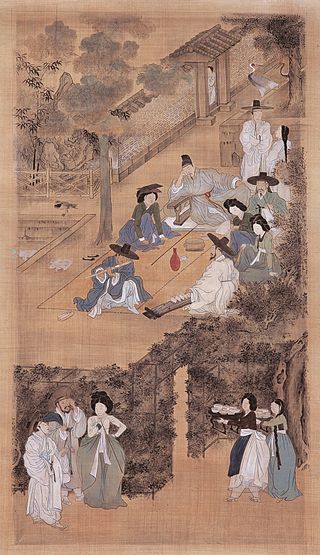
Society in the Joseon dynasty was built upon Neo-Confucianist ideals, namely the three fundamental principles and five moral disciplines. There were four classes: the yangban nobility, the "middle class" jungin, sangmin, or the commoners, and the cheonmin, the outcasts at the very bottom. Society was ruled by the yangban, who constituted 10% of the population and had several privileges. Slaves were of the lowest standing.
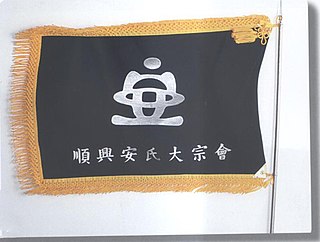
The Sunheung Ahn clan is a clan connected with the town of Sunheung, South Korea, and was well known during the Goryeo Dynasty and in the early Joseon Dynasty for its so-called "blue-blood" status.
